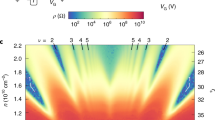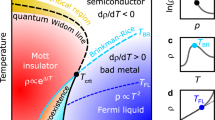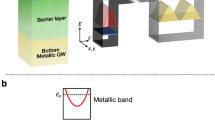Abstract
Semiconducting field-effect transistors are the workhorses of the modern electronics era. Recently, application of the field-effect approach to compounds other than semiconductors has created opportunities to electrostatically modulate types of correlated electron behaviour—including high-temperature superconductivity and colossal magnetoresistance—and potentially tune the phase transitions in such systems. Here we provide an overview of the achievements in this field and discuss the opportunities brought by the field-effect approach.
This is a preview of subscription content, access via your institution
Access options
Subscribe to this journal
Receive 51 print issues and online access
$199.00 per year
only $3.90 per issue
Buy this article
- Purchase on Springer Link
- Instant access to full article PDF
Prices may be subject to local taxes which are calculated during checkout




Similar content being viewed by others
References
Jérome, D. & Caron, L. G. (eds) Low-Dimensional Conductors and Superconductors (NATO Advanced Study Institutes, Ser. B, Vol. 155, Plenum, New York, 1987)
Shaw, J. M. & Seidler, P. F. (eds) Organic electronics. IBM J. Res. Dev. 45(1), 3–128 (2001)
Bednorz, J. G. & Müller, K. A. Possible high Tc superconductivity in the Ba-La-Cu-O system. Z. Phys. B 64, 189–193 (1986)
Wu, M. K. et al. Superconductivity at 93 K in a new mixed-phase Y-Ba-Cu-O compound system at ambient pressure. Phys. Rev. Lett. 58, 908–912 (1987)
Tokura, Y. (ed.) Colossal Magnetoresistive Oxides (Advances in Condensed Matter Science, Vol. 2, Gordon and Breach, London, 2000)
Mannhart, J. High-Tc transistors. Supercond. Sci. Technol. 9, 49–67 (1996)
Results of Inquiry Into the Validity of Certain Physics Research Papers from Bell Labs. Available at 〈http://www.lucent.com/news_events/researchreview.html〉 (2002).
Mott, N. Metal-Insulator Transitions (Taylor and Francis, London, 1990)
de Picciotto, R. et al. 2D–1D coupling in cleaved edge overgrowth. Phys. Rev. Lett. 85, 1730–1733 (2000)
Orenstein, J. & Millis, A. J. Advances in the physics of high-temperature superconductivity. Science 288, 468–474 (2000)
Abrahams, E., Kravchenko, S. V. & Sarachik, M. P. Colloquium: Metallic behavior and related phenomena in two dimensions. Rev. Mod. Phys. 73, 251–266 (2001)
Wigner, E. On the interaction of electrons in metals. Phys. Rev. 46, 1002–1011 (1934)
Kravchenko, S. V. et al. Scaling of an anomalous metal-insulator transition in a two dimensional system in silicon at B = 0. Phys. Rev. B 51, 7038–7045 (1995)
Imada, M., Fujimori, A. & Tokura, Y. Metal-insulator transitions. Rev. Mod. Phys. 70, 1039–1263 (1998)
Stormer, H. L., Tsui, D. C. & Gossard, A. C. The fractional quantum Hall Effect. Rev. Mod. Phys. 71, S298–S305 (1999)
Chu, C. W. Materials and physics of high temperature superconductors: A summary, two recent experiments and a comment. Physica Scripta T 102, 40–50 (2002)
Christen, H.-M., Mannhart, J., Williams, E. J. & Gerber, Ch. Dielectric properties of sputtered SrTiO3 films. Phys. Rev. B 49, 12095–12104 (1994)
Ahn, C. H. et al. Electrostatic modulation of superconductivity in ultra-thin GdBa2Cu3O7 films. Science 284, 1152–1155 (1999)
The International Technology Roadmap for Semiconductors 2002. Available at 〈http://public.itrs.net/〉 (2002).
Hubbard, K. J. & Schlom, D. G. Thermodynamic stability of binary oxides in contact with silicon. J. Mater. Res. 11, 2757–2776 (1996)
McKee, R. A., Walker, F. J. & Chisholm, M. F. Crystalline oxides on silicon: The first five monolayers. Phys. Rev. Lett. 81, 3014–3017 (1998)
Lin, A. et al. Epitaxial growth of Pb(Zr0.2Ti0.8)O3 on Si and its nanoscale piezoelectric properties. Appl. Phys. Lett. 78, 2034–2036 (2001)
Glover, R. E. & Sherill, M. D. Changes in superconducting critical temperature produced by electrostatic charging. Phys. Rev. Lett. 5, 248–250 (1960)
Hebard, A. F. & Fiory, A. T. in Novel Superconductivity (eds Wolf, S. A. & Kresin, V. Z.) 9 (Plenum, New York, 1987)
Mannhart, J., Bednorz, J. G., Müller, K. A. & Schlom, D. G. Electric field effect on superconducting YBa2Cu3O7-δ films. Z. Phys. B 83, 307–311 (1991)
Levy, A. et al. Field and Hall effects in semiconducting YBa2Cu3O6+δ . Phys. Rev. B 46, 520–523 (1992)
Xi, X. X. et al. Effects of field-induced hole-density modulation on normal-state and superconducting transport in YBa2Cu3O7-x . Phys. Rev. Lett. 68, 1240–1243 (1992)
Ivanov, Z. G., Stepantsov, E. A., Tzalenchuk, A., Ya, Shekhter, R. I. & Claeson, T. Field effect transistor based on a bi-crystal grain boundary Josephson junction. IEEE Trans. Appl. Supercond. 3, 2925–2927 (1993)
Joosse, K. et al. Electric-field effect devices made of YBa2Cu3O7-x/SrTiO3 epitaxial multilayers. Physica C 224, 179–184 (1994)
Matijasevic, V. C. et al. Electric field induced superconductivity in an overdoped copper oxide superconductor. Physica C 235–240, 2097–2098 (1994)
Mannhart, J., Ströbel, J., Bednorz, J. G. & Gerber, Ch. Large electric field effects in YBa2Cu3O7-δ films containing weak links. Appl. Phys. Lett. 62, 630–632 (1993)
Mayer, B., Mannhart, J. & Hilgenkamp, H. Electric-field controllable Josephson junctions of high quality in high-Tc superconductors. Appl. Phys. Lett. 68, 3031–3033 (1996)
Watanabe, Y. Epitaxial all-perovskite field effect transistor with a memory retention. Appl. Phys. Lett. 66, 1770–1772 (1995)
Aidam, R., Fuchs, D. & Schneider, R. Ferroelectric field effect in YBa2Cu3O7-δ thin films. Physica C 328, 21–30 (1999)
Goldman, A. M. & Markovic, N. Superconductor-insulator transitions in the two-dimensional limit. Phys. Today 51, 39–44 (1998)
Sachdev, S. Quantum Phase Transitions (Cambridge Univ. Press, Cambridge, 1999)
Boebinger, G. S. et al. Insulator-to-metal crossover in the normal state of La2-xSrxCuO4 near optimum. Phys. Rev. Lett. 77, 5417–5420 (1996)
Emery, V. J. & Kivelson, S. A. Superconductivity in bad metals. Phys. Rev. Lett. 74, 3253–3256 (1995)
Schneider, T. & Singer, J. M. Crossover and quantum critical phenomena in high temperature superconductors. Europhys. Lett. 40, 79–84 (1997)
Uemura, Y. J. et al. Magnetic field penetration depth in Tl2Ba2CuO6+δ in the overdoped regime. Nature 364, 605–607 (1993)
Matthey, D., Gariglio, S., Ahn, C. H. & Triscone, J.-M. Electrostatic modulation of the superconducting transition in thin NdBa2Cu3O7-δ films: The role of classical fluctuations. Physica C 372–376, 583–586 (2002)
Gariglio, S., Ahn, C. H., Matthey, D. & Triscone, J.-M. Electrostatic tuning of the hole density in NdBa2Cu3O7-δ films and its effect on the Hall response. Phys. Rev. Lett. 88, 67002 (2002)
Mathews, S., Ramesh, R., Vankatesan, T. & Benedetto, J. Ferroelectric field effect transistor based on epitaxial perovskite heterostructures. Science 276, 238–240 (1997)
Tanaka, H., Zhang, J. & Kawai, T. Giant electric field modulation of double exchange ferromagnetism at room temperature in the perovskite manganite/titanate p-n junction. Phys. Rev. Lett. 88, 027204 (2002)
Hong, X., Posadas, A. & Ahn, C. H. Structural and electronic properties of PZT/ultrathin LaxSr1-xMnO3 heterostructures for ferroelectric field effect studies. Solid State Electron (in the press)
Newns, D. M. et al. Mott transition field effect transistor. Appl. Phys. Lett. 73, 780–782 (1998)
Ueno, K. et al. Field-effect transistor on SrTiO3 with sputtered Al2O3 gate insulator. Proc. M2S 2003 Conf. (in the press); preprint at 〈http://xxx.lanl.gov/cond-mat/0306436〉 (2003).
Ahn, C. H. et al. Local nonvolatile electronic writing of epitaxial Pb(Zr,Ti)O3/SrRuO3 heterostructures. Science 276, 1100–1103 (1997)
Mathur, N. & Littlewood, P. Mesoscopic texture in manganites. Phys. Today 56, 25–30 (2003)
Levi, B. G. Do atomic force microscope arrays have the write stuff? Phys. Today 55, 14–17 (2002)
Acknowledgements
We acknowledge discussions with, and support from, T. Giamarchi, A. Lin, A. Sawa, D. G. Schlom, C. W. Schneider and C. C. Tsuei. C.A. was supported by AFOSR, DOE, NSF and the Packard Foundation; J.M. was supported by BMBF, ESF (Thiox) and SFB; J.M.T. was supported by the Swiss National Science Foundation through the National Centre of Competence in Research, ‘Materials with Novel Electronic Properties’ and division II, NEDO, and ESF (Thiox).
Author information
Authors and Affiliations
Corresponding authors
Rights and permissions
About this article
Cite this article
Ahn, C., Triscone, JM. & Mannhart, J. Electric field effect in correlated oxide systems. Nature 424, 1015–1018 (2003). https://doi.org/10.1038/nature01878
Issue Date:
DOI: https://doi.org/10.1038/nature01878
This article is cited by
-
Stoner instability-mediated large magnetoelectric effects in 2D stacking electrides
npj Computational Materials (2024)
-
Zero-dimensionality of a scaled-down VO2 metal-insulator transition via high-resolution electrostatic gating
NPG Asia Materials (2023)
-
Recent development of E-field control of interfacial magnetism in multiferroic heterostructures
Nano Research (2023)
-
Observation of metallic electronic structure in a single-atomic-layer oxide
Nature Communications (2021)
-
Resonant tunneling driven metal-insulator transition in double quantum-well structures of strongly correlated oxide
Nature Communications (2021)
Comments
By submitting a comment you agree to abide by our Terms and Community Guidelines. If you find something abusive or that does not comply with our terms or guidelines please flag it as inappropriate.



